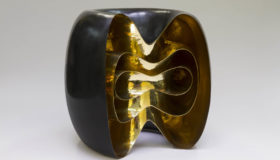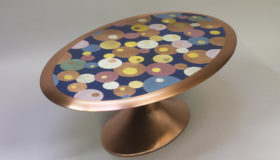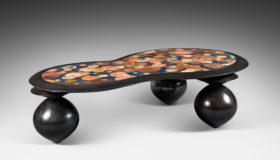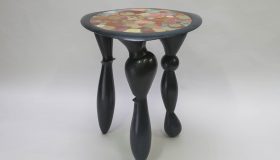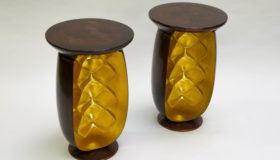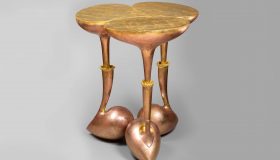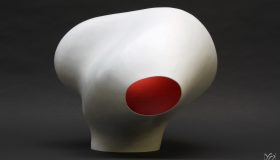“Like an elite athlete, you constantly need to exert emotional and physical control. I’m a craftsman with an artistic vision.” (Nathanaël Le Berre)
You work alone. How much have other people – artists or otherwise – influenced you?
People play a vital role in cultivating my vision, but they also enable me to get some sort of perspective on my work and its evolution. My studies and experimentations sparked my curiosity and admiration for artists and designers such as Goudji, Tony Cragg, Simon Hantaï, Bernard Frize, André Dubreuil, and Eric Schmitt. I should also mention Andrei Rublev: his icons have been with me since childhood. My teachers at École nationale supérieure des Arts appliqués et des Métiers d’art (ENSAAMA), Michel Raffestin, Fred Barnley, Jean-Jacques Victor, and Hervé Wahlen (whom I met at my final assessment) also shaped my vision. Later on, people like Christian Liaigre, Patrick Fourtin and Michèle Hayem inspired me to transform and develop my approach.
How would you define yourself? As an artist, a craftsman, a sculptor, a designer, a metalworker?
I’m an artist who uses a craftsman’s technique. I use freehand metalwork, a dying art, to create shapes that are a combination of things I imagine and things I see around me. I think of myself as a sculptor, even though my work is evolving toward more functional pieces. I’m not a designer, although some of my pieces combine form with function. My goal is always to create an artistic work that reflects my aesthetics.
How important was your work with sculptor Hervé Wahlen?
His training allowed me to understand the tension of form and space. I learned how to create curves and flat surfaces. I must say I wasn’t too keen on all those tricky manual techniques initially, but I mastered them with his help. Hervé taught me precision, which is essential in our line of work. It’s like being an elite athlete; you constantly need to exert emotional and physical control. He’s a very imposing figure, and it took a while to step out of his shadow. But he didn’t want me to be like him. I worked with him on his pieces. Once I understood his approach, his technique, I was able to find my own style, and then move on to larger scale works.
You started out with steel, and now copper. Do you feel constricted by these materials, or do they enable your work?
Ever since I became interested in metal, I’ve been fascinated by the way a sheet can be transformed into complex shapes just by hammering and heating. I like the sense of space created by the openings in a sculpture, allowing the viewer to really get into it. That’s why I never limited myself to finite spaces; rather, I tried to open them up. The physicality of the artist influences the shape of his work. Working with sheet metal opens up possibilities, but it’s also very technically demanding. Metal is like an incredible emotional sponge; it’s extremely responsive. But it’s also unrelenting work, demanding your full attention–physically, emotionally and intellectually. Nevertheless, there’s also room for fortuitous discoveries–the possibility of ending up somewhere you hadn’t envisioned.
How would you describe your work, and your evolution?
My work is solitary, but I do it for others. I love the idea that my work can move people, that the shapes might resonate with them. Art bring us together. It’s something deeply personal but it can be felt by each and every one of us. I’m slowly expanding my horizon to include more functional objects. In the beginning, I concentrated heavily on the actual process of working the material. I needed to produce, to develop my style, and to take a “purist” approach. My repertoire of shapes has since expanded and changed, and I’m now working on more monumental pieces, which involve increased technical challenges but help me to develop as an artist. My approach to finishing has also changed. When I was younger, I was rather dismissive of this aspect of my work. In the end, I realised how important it is. Working with Christian Liaigre helped me see this. He sees the finish as the link between the completed work and its audience.
What’s your relationship to your pieces once they are complete?
I don’t feel any particular connection. Once I’m done with them, they no longer belong to me; they’re meant for a gallery or a buyer. If I keep one, it means my work isn’t complete. The collection I am currently developing won’t be kept in the workshop. It’s meant to be displayed.
Why did you enter the Liliane Bettencourt competition for craftsmanship, L’Intelligence de la main?
At a certain point in my career, I felt the need to get new feedback on my work. I wanted it to be studied by a panel of professionals. Initially, I entered with my piece Eye Eve. The following year, it was Mallorca, but something was missing. In the end, I realised that I needed to push my art further, to highlight my hammering style in order to leave a more tangible presence on the finished work. I had already created a series of sculptures inspired by cut down fruit. One, in particular, revolved around the symbol for infinity. I began with this piece and created an even more technically challenging version, with a highly refined polished interior. That’s how I came up with L’Infini, which uses traditional metalworking methods of shape composition (specifically, the rotation technique). It was awarded the “exceptional talent” prize in 2014.
What did it mean to you?
Recognition for my work, naturally, and for the young provincial man I was when I moved to Paris for my studies. I felt vindicated for all those years spent working hard, by myself, in obscurity. The prize also helps bring attention to a disappearing profession, and brings it back into the spotlight. Aside from the prize itself, I was the first winner to be given support over three years by the Foundation Bettencourt Schueller. I now have the security I need to develop my projects. When you start out, you have to work hard with very few resources. Financially speaking, you only plan for the short term. With the Foundation’s support, I was able to free myself from that, in order to concentrate on creating. The recognition also meant I was able to develop a collection with complete creative freedom. Nothing will be made to order. It allowed me to let loose my creativity and move forward with confidence.





